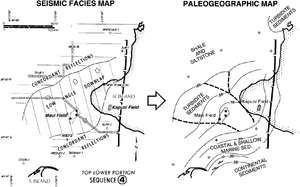Difference between revisions of "Mapping paleogeography"
Jump to navigation
Jump to search

(Initial import) |
Cwhitehurst (talk | contribs) m (added Category:Treatise Handbook 3 using HotCat) |
||
| (11 intermediate revisions by 2 users not shown) | |||
| Line 6: | Line 6: | ||
| part = Predicting the occurrence of oil and gas traps | | part = Predicting the occurrence of oil and gas traps | ||
| chapter = Exploring for stratigraphic traps | | chapter = Exploring for stratigraphic traps | ||
| − | | frompg = 21- | + | | frompg = 21-52 |
| − | | topg = 21- | + | | topg = 21-52 |
| author = John C. Dolson, Mike S. Bahorich, Rick C. Tobin, Edward A. Beaumont, Louis J. Terlikoski, Michael L. Hendricks | | author = John C. Dolson, Mike S. Bahorich, Rick C. Tobin, Edward A. Beaumont, Louis J. Terlikoski, Michael L. Hendricks | ||
| link = http://archives.datapages.com/data/specpubs/beaumont/ch21/ch21.htm | | link = http://archives.datapages.com/data/specpubs/beaumont/ch21/ch21.htm | ||
| Line 14: | Line 14: | ||
| isbn = 0-89181-602-X | | isbn = 0-89181-602-X | ||
}} | }} | ||
| − | Paleogeographic maps are the end product of the sequence stratigraphic analysis. Favorable sites for deposition of reservoir, seal, and source | + | [[Paleogeography|Paleogeographic]] maps are the end product of the [[Basics of sequence stratigraphy|sequence stratigraphic]] analysis. Favorable sites for deposition of [[Reservoir quality|reservoir]], [[seal]], and [[source rock]]s can be ascertained from paleogeographic maps. |
==Procedure== | ==Procedure== | ||
The table below outlines a procedure for making paleogeographic maps. | The table below outlines a procedure for making paleogeographic maps. | ||
| − | + | # With objectives in mind, choose intervals to map. Is the target within one [[Depositional sequence identification|depositional sequence]]? Is the target the entire section? | |
| − | + | # Choose the level of detail. Do you need to map the paleogeography at the level of a depositional sequence or a [[Systems tracts and trap types|systems tract]]? | |
| − | + | # Construct paleogeographic maps using all available information. | |
| − | |||
| − | |||
| − | |||
| − | |||
| − | |||
| − | |||
| − | |||
| − | |||
| − | |||
| − | |||
| − | |||
==Example== | ==Example== | ||
| − | |||
| − | [[file:exploring-for-stratigraphic-traps_fig21-34.png|thumb|{{figure number| | + | [[file:exploring-for-stratigraphic-traps_fig21-34.png|300px|thumb|{{figure number|1}}Seismic facies map and corresponding paleogeographic map of the Middle Miocene Taranaki basin, offshore western New Zealand. From Bally;<ref name=Bally1987>Bally, A. W., ed., 1987, Atlas of Seismic Stratigraphy: [http://store.aapg.org/detail.aspx?id=478 AAPG Studies in Geology 27], vol. 1, 124 p.</ref> courtesy AAPG.]] |
| + | |||
| + | [[:file:exploring-for-stratigraphic-traps_fig21-34.png|Figure 1]] is a [[Seismic facies mapping|seismic facies map]] and the corresponding paleogeographic map of the Middle Miocene Taranaki basin, offshore western New Zealand. The paleogeographic map depicts [[lithofacies]] and thicknesses in two-way time. | ||
==See also== | ==See also== | ||
| Line 44: | Line 34: | ||
* [[Mapping unconformities]] | * [[Mapping unconformities]] | ||
* [[Analyzing depositional sequences for traps]] | * [[Analyzing depositional sequences for traps]] | ||
| + | |||
| + | ==References== | ||
| + | {{reflist}} | ||
==External links== | ==External links== | ||
| Line 52: | Line 45: | ||
[[Category:Predicting the occurrence of oil and gas traps]] | [[Category:Predicting the occurrence of oil and gas traps]] | ||
[[Category:Exploring for stratigraphic traps]] | [[Category:Exploring for stratigraphic traps]] | ||
| + | [[Category:Treatise Handbook 3]] | ||
Latest revision as of 20:13, 4 February 2022
| Exploring for Oil and Gas Traps | |

| |
| Series | Treatise in Petroleum Geology |
|---|---|
| Part | Predicting the occurrence of oil and gas traps |
| Chapter | Exploring for stratigraphic traps |
| Author | John C. Dolson, Mike S. Bahorich, Rick C. Tobin, Edward A. Beaumont, Louis J. Terlikoski, Michael L. Hendricks |
| Link | Web page |
| Store | AAPG Store |
Paleogeographic maps are the end product of the sequence stratigraphic analysis. Favorable sites for deposition of reservoir, seal, and source rocks can be ascertained from paleogeographic maps.
Procedure
The table below outlines a procedure for making paleogeographic maps.
- With objectives in mind, choose intervals to map. Is the target within one depositional sequence? Is the target the entire section?
- Choose the level of detail. Do you need to map the paleogeography at the level of a depositional sequence or a systems tract?
- Construct paleogeographic maps using all available information.
Example

Figure 1 Seismic facies map and corresponding paleogeographic map of the Middle Miocene Taranaki basin, offshore western New Zealand. From Bally;[1] courtesy AAPG.
Figure 1 is a seismic facies map and the corresponding paleogeographic map of the Middle Miocene Taranaki basin, offshore western New Zealand. The paleogeographic map depicts lithofacies and thicknesses in two-way time.
See also
- Basin-fill and trap analysis
- Procedure for basin-fill analysis
- Mapping unconformities
- Analyzing depositional sequences for traps
References
- ↑ Bally, A. W., ed., 1987, Atlas of Seismic Stratigraphy: AAPG Studies in Geology 27, vol. 1, 124 p.